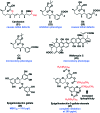Targeting S. mutans biofilms: a perspective on preventing dental caries
- PMID: 31391878
- PMCID: PMC6644389
- DOI: 10.1039/c9md00015a
Targeting S. mutans biofilms: a perspective on preventing dental caries
Abstract
The prevalence of biofilm diseases, and dental caries in particular, have encouraged extensive research on S. mutans biofilms, including methods of preventing its formation. Numerous small molecules with specific anti-biofilm activity against this pathogen have been isolated and synthesized. Generally, these molecules can be characterized into three categories: sucrose-dependent anti-adhesion, sucrose-independent anti-adhesion and cellular signaling interference. This review aims to provide an overview of the current small molecule strategies used for targeting S. mutans biofilms, and a perspective of the future for the field.
Figures






Similar articles
-
Effect of Rubusoside, a Natural Sucrose Substitute, on Streptococcus mutans Biofilm Cariogenic Potential and Virulence Gene Expression In Vitro.Appl Environ Microbiol. 2020 Aug 3;86(16):e01012-20. doi: 10.1128/AEM.01012-20. Print 2020 Aug 3. Appl Environ Microbiol. 2020. PMID: 32503907 Free PMC article.
-
Raffinose Inhibits Streptococcus mutans Biofilm Formation by Targeting Glucosyltransferase.Microbiol Spectr. 2022 Jun 29;10(3):e0207621. doi: 10.1128/spectrum.02076-21. Epub 2022 May 16. Microbiol Spectr. 2022. PMID: 35575506 Free PMC article.
-
Targeting of Streptococcus mutans Biofilms by a Novel Small Molecule Prevents Dental Caries and Preserves the Oral Microbiome.J Dent Res. 2017 Jul;96(7):807-814. doi: 10.1177/0022034517698096. Epub 2017 Mar 10. J Dent Res. 2017. PMID: 28571487 Free PMC article.
-
Inhibition of Streptococcus mutans biofilm formation by strategies targeting the metabolism of exopolysaccharides.Crit Rev Microbiol. 2021 Sep;47(5):667-677. doi: 10.1080/1040841X.2021.1915959. Epub 2021 May 3. Crit Rev Microbiol. 2021. PMID: 33938347 Review.
-
[Latest Findings on Polyketides/Non-ribosomal Peptides That Are Secondary Metabolites of Streptococcus mutans].Sichuan Da Xue Xue Bao Yi Xue Ban. 2023 May;54(3):685-691. doi: 10.12182/20230560302. Sichuan Da Xue Xue Bao Yi Xue Ban. 2023. PMID: 37248606 Free PMC article. Review. Chinese.
Cited by
-
43-Year Temporal Trends in Immune Response to Oral Bacteria in a Swedish Population.Pathogens. 2020 Jul 7;9(7):544. doi: 10.3390/pathogens9070544. Pathogens. 2020. PMID: 32645865 Free PMC article.
-
Antibacterial and Antibiofilm Activity of Carvacrol against Oral Pathogenic Bacteria.Metabolites. 2022 Dec 13;12(12):1255. doi: 10.3390/metabo12121255. Metabolites. 2022. PMID: 36557293 Free PMC article.
-
The suppression effect of SCH-79797 on Streptococcus mutans biofilm formation.J Oral Microbiol. 2022 Apr 18;14(1):2061113. doi: 10.1080/20002297.2022.2061113. eCollection 2022. J Oral Microbiol. 2022. PMID: 35480051 Free PMC article.
-
Isolation of Streptococcus mutans temperate bacteriophage with broad killing activity to S. mutans clinical isolates.iScience. 2023 Nov 14;26(12):108465. doi: 10.1016/j.isci.2023.108465. eCollection 2023 Dec 15. iScience. 2023. PMID: 38089578 Free PMC article.
-
Proteomics of Streptococcus mutans to Reveal the Antibiofilm Formation Mechanism of Ag/ZnO Nanocomposites with Light-Emitting Diode Radiation.Int J Nanomedicine. 2021 Nov 19;16:7741-7757. doi: 10.2147/IJN.S333432. eCollection 2021. Int J Nanomedicine. 2021. PMID: 34848957 Free PMC article.
References
-
- Kilian M., Chapple I. L. C., Hannig M., Marsh P. D., Meuric V., Pedersen A. M. L., Tonetti M. S., Wade W. G., Zaura E. Br. Dent. J. 2016;221:657. - PubMed
-
- U.S. Department of Health and Human Services, Oral Health in America: A Report of the Surgeon General, 2000.
Publication types
Grants and funding
LinkOut - more resources
Full Text Sources

